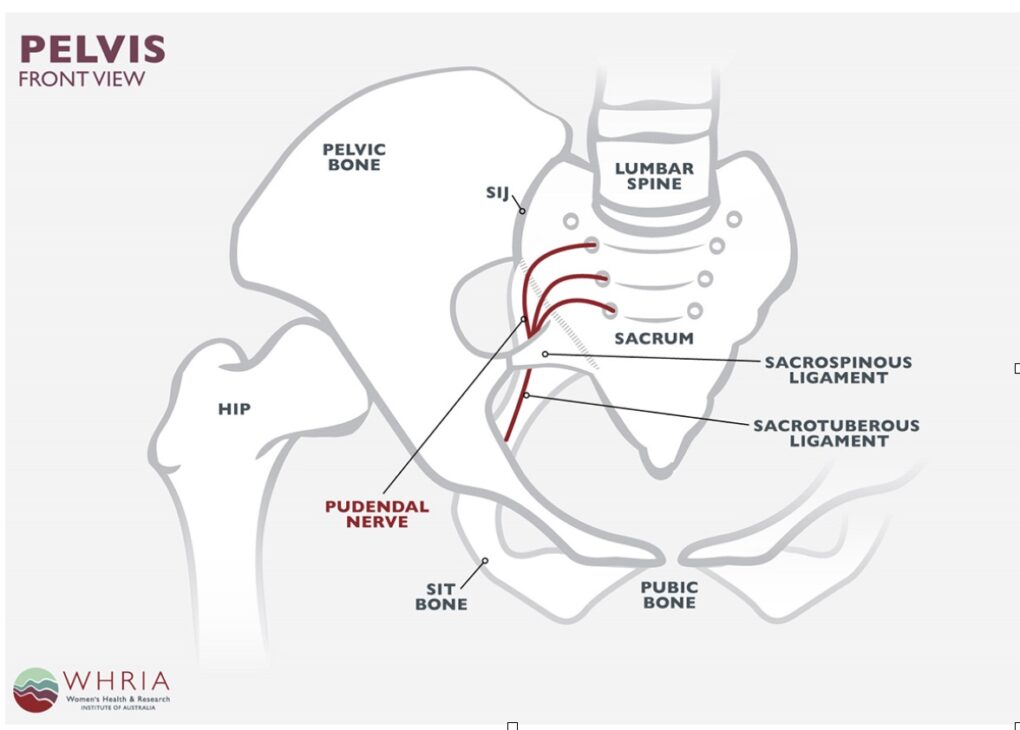What is Pudendal Nerve Pain?
Pudendal nerve pain or Pudendal neuralgia is the term given to long term pain caused by irritation or damage to the
pudendal nerve. The pudendal nerve runs from the lower back, along the pelvic floor and into
the perineum. The pudendal nerve’s function is to provide sensation to the skin between the
anus and clitoris or penis as well as the muscles around the anus and urethra.

https://www.whria.com.au/for-patients/pelvic-pain/pudendal-neuralgia/
The nerves in our body need to be able to glide and stretch, when we move our bodies our nerves are gliding and moving as well. They can withstand some compression for some time because we get signals to move, for example when we get pins and needles in our arm after laying in a position for too long.
Often there is a combination of factors contributing to the cause but some of the common causes of Pudendal neuralgia can include:
- Repetitive compression of the pudendal nerve e.g. riding bikes
- Childbirth
- Past pelvic trauma
- Pelvic floor dysfunction
- Gynecological or colorectal surgery
- Excessive exercise
- Stress
Symptoms of Pudendal Nerve Pain
Symptoms vary for everyone, some symptoms may include:
- UTI sensation
- Pain with sexual intercourse (before, during or after)
- Pain with sitting
- Pain in perineum
- Bowel or bladder problems
Diagnosis and Treatment
After discussing with a health practitioner, they will perform a physical examination which will assess the integrity of the musculoskeletal and nervous system of the lower back and pelvic region. They may also choose to refer for further testing such as a pudendal nerve block, MRI or pelvic floor ultrasounds.
There are numerous different options for treatment. Conservative treatment options might include the following:
- Pelvic Floor physiotherapist: teach you ways to relax the pelvic floor as well as provide exercises and/or stretches that can be done at home.
- Osteopath: may be able to reduce tension of the muscles, ligaments and joints around the lower back and pelvis to reduce nerve irritation.
- Acupuncture
- Psychology
- Pharmacological intervention: medication to help relax the nervous system
Some lifestyle changes can be done to try and reduce the irritation of the nerve. Some common ones include:
- Trying not to strain when going to the bathroom
- Using a donut cushion to reduce the pressure on the perineum
- Decrease the amount you sit during the day, utilize a sit stand desk when having to spend a long time at the desk
- Reducing or avoiding physical activities that are irritating
- Sleep hygiene – getting adequate sleep helps reduce nervous system sensitivity as well as stress
All advice given is general. Please consult a health care professional to see if the advice is suitable for your condition.
For more information head to https://www.whria.com.au/for-patients/pelvic-pain/pudendal-neuralgia/
References
- Pudendal neuralgia. (2022). Retrieved 18 July 2022, from https://www.nhs.uk/conditions/pudendal-neuralgia/
- Pudendal Neuralgia Treatment & Symptoms – WHRIA. (2022). Retrieved 18 July 2022, from https://www.whria.com.au/for-patients/pelvic-pain/pudendal-neuralgia/
- Z.9, a. (2012). A musculoskeletal approach for patients with pudendal neuralgia: a cohort study – BJUI. Retrieved 18 July 2022, from https://www.bjuinternational.com/case-studies/a-musculoskeletal-approach-for-patients-with-pudendal-neuralgia-a-cohort-study/
Written by: Associate Osteopath, Dr Dr Belicia Ralph.

Belicia works at both our New Farm and Brisbane City Clinics, Monday to Friday.
To make an appointment with Bel please use our booking link below
